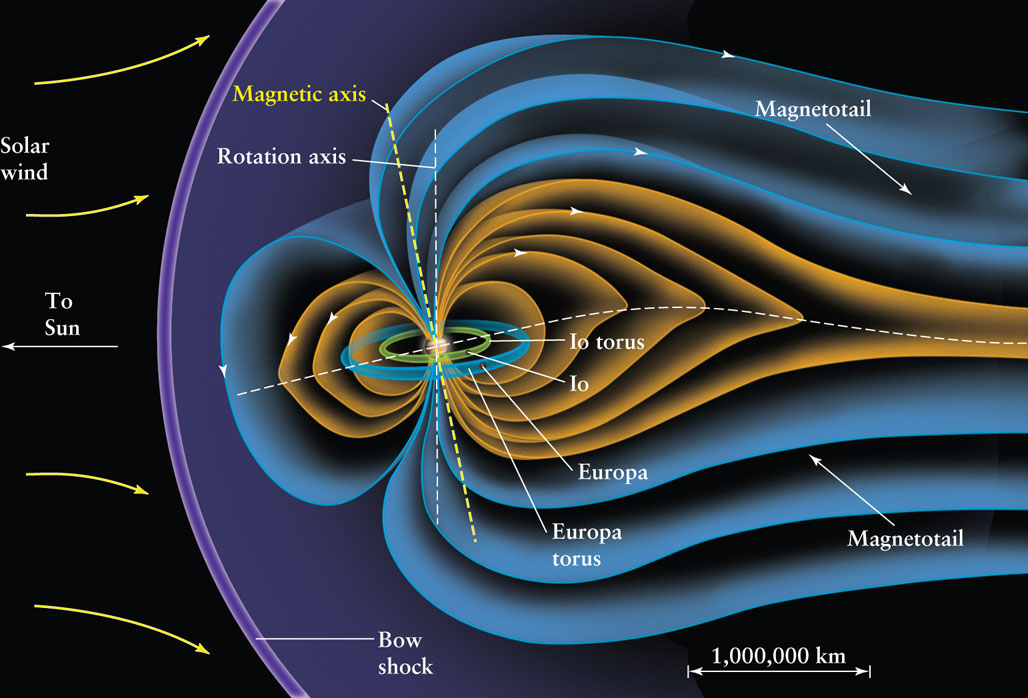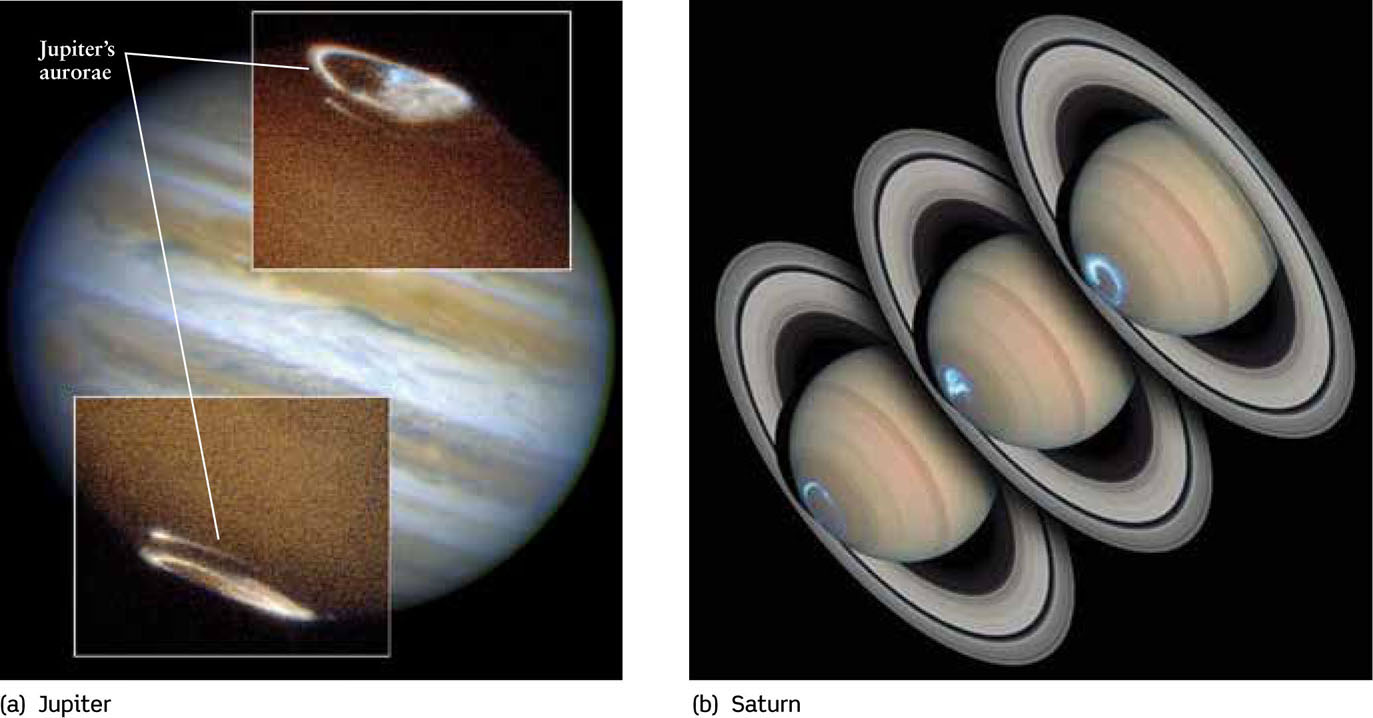12-7 Metallic hydrogen inside Jupiter and Saturn endows the planets with strong magnetic fields
The oblateness of Jupiter and Saturn gives information about the size of the planets’ rocky cores. However, oblateness does not provide much insight into the liquid surrounding the planets’ cores. Just as with Earth, a window into a planet’s inner workings can come from a global magnetic field.
Jupiter’s Magnetic Field
Measurements by the Pioneer and Voyager spacecraft detected a magnetic field and indicate that the field at Jupiter’s equator is 14 times stronger than at Earth’s equator. Like Earth’s magnetic field, Jupiter’s field is thought to be generated by motions of an electrically conducting fluid in the planet’s interior. But wholly unlike Earth, the moving fluid within Jupiter is an exotic form of hydrogen called liquid metallic hydrogen.
As we discussed in Section 7-7, hydrogen becomes a liquid metal only when the pressure exceeds about 1.4 million atmospheres. This pressure occurs at depths more than about 7000 km below Jupiter’s cloudtops. Thus, the internal structure of Jupiter consists of four distinct regions, as shown in Figure 12-13a: a rocky core, a roughly 3000-km thick layer of liquid “ices,” a layer of helium and liquid metallic hydrogen about 56,000 km thick, and a layer of helium and ordinary hydrogen about 7000 km thick. The colorful cloud patterns that we can see through telescopes are located in the outermost 100 km of the outer layer.
Figure 12-13a shows that much of the enormous bulk of Jupiter is composed of liquid metallic hydrogen. Jupiter’s rapid rotation sets the liquid metallic hydrogen into motion, giving rise to a powerful dynamo 20,000 times stronger than Earth’s and generating an intense magnetic field.
Saturn’s Magnetic Field
Saturn also has a substantial magnetic field, but it pales by Jupiter standards: Saturn’s internal dynamo is only 3% as strong as Jupiter’s. (To be fair, it is still 600 times stronger than Earth’s dynamo!) This difference between the planets suggests that even though Saturn rotates nearly as rapidly as Jupiter, there must be far less liquid metallic hydrogen within Saturn to be stirred up by the rotation and thereby generate a magnetic field. This conclusion makes sense: Compared to Jupiter, Saturn has less mass, less gravity, and less internal pressure to compress ordinary hydrogen into liquid metallic hydrogen. As a consequence, as Figure 12-13 shows, liquid metallic hydrogen probably makes up only a relatively small fraction of Saturn’s bulk.
Jupiter’s Magnetosphere
Both Jupiter and Saturn have magnetospheres that are millions of kilometers across
Jupiter’s strong magnetic field surrounds the planet with a magnetosphere so large that it envelops the orbits of many of its moons (Figure 12-14). The Pioneer and Voyager spacecraft that carried instruments to detect charged particles and magnetic fields, revealed the awesome dimensions of the Jovian magnetosphere. If you could see Jupiter’s magnetosphere from Earth, it would cover an area in the sky 16 times larger than the Moon!

As charged particles in the solar wind collide with the Jovian magnetosphere, they slow down, creating a region called a bow shock. The bow shock marks the transition between the magnetosphere and the surrounding space. Deeper within Jupiter’s magnetosphere, charged particles—also referred to as ions—are trapped in belts that are analogous to Earth’s Van Allen belts (recall Figure 9-19). An astronaut venturing into these belts would quickly receive a lethal dose of this charged-particle radiation.
A major source for charged particles in Jupiter’s magnetosphere is the moon Io (see Table 7-2). Io’s active volcanoes eject about a ton of material into Jupiter’s magnetosphere each second. As shown in Figure 12-14, these particles form a torus.
Saturn’s Magnetosphere
Saturn’s magnetosphere is similar to Jupiter’s, but is only about 10 to 20% as large and contains far fewer charged particles than Jupiter’s. There are two reasons for this deficiency. First, Saturn lacks a highly volcanic moon like Io to inject particles into the magnetosphere. Second, and more important, many charged particles are absorbed by the icy particles that make up Saturn’s rings (see Section 12-10). As with Jupiter, the charged particles that do exist in Saturn’s magnetosphere are concentrated in radiation belts similar to the Van Allen belts in Earth’s magnetosphere.
Aurorae on Jupiter and Saturn
On Earth, charged particles trapped in our planet’s magnetic field stream onto the north and south magnetic poles, creating the aurora (see Section 9-4). The same effect takes place on both Jupiter and Saturn. Figure 12-15 shows images from the Hubble Space Telescope that reveal glowing auroral rings centered on the magnetic poles of Jupiter and of Saturn. As on Earth, the emission comes from a region high in each planet’s atmosphere, hundreds of kilometers above the cloudtops.

Aurorae on Jupiter and Saturn These images combine visible wavelengths of the planets, and ultraviolet light from the aurorae. On both Jupiter and Saturn, charged particles from the magnetosphere are funneled onto the planet’s magnetic poles. When the particles collide with and excite molecules in the upper atmosphere, the molecules emit ultraviolet light. In (b), a large disturbance in the solar wind approaching Saturn coincided with the brightening of the aurora in the middle image of the three.
CONCEPT CHECK 12-7
Consider Figure 12-14 and Figure 12-15a. Could charged particles from volcanoes on the moon Io lead to brighter aurorae on Jupiter?
Yes. Some charged particles ejected by Io’s volcanism can join the ion-trapping belts around Jupiter. Just as on Earth, when these ions stream along the magnetic field, they can cause aurorae at Jupiter’s magnetic poles.